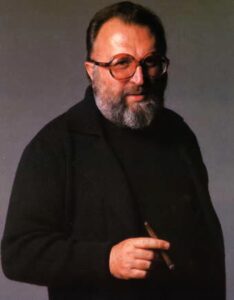Essential DVDs: A Fistful of Dollars (1964); For a Few Dollars More (1965); The Good, The Bad And The Ugly (1966); Once Upon A Time In The West (1968); Once Upon A Time In America (1984)
Oscars: None
In His Own Words: “I can’t see America any other way than with a European’s eyes, obviously; it fascinates me and terrifies me at the same time.”
After the muscle-man quickie The Colossus Of Rhodes, Sergio Leone directed a mere six films, making up two trilogies, the ‘dollars’ films about Clint Eastwood’s Man With No Name (A Fistful Of Dollars, For A Few Dollars More, The Good, The Bad And The Ugly) and a panoramic trio (Once Upon A Time In The West, Duck, You Sucker, Once Upon A Time In America) about corruption and power in the New World.
It was said that Leone’s Westerns were ‘realistic’ depictions of grim 19th century Tex-Mex frontier life, but actually they are stark, simple fables. Though the body counts are higher, his Westerns tend to be as morally cut-and-dried as any kiddie matinee oater. Appropriately, His world is divided into good, bad and ugly. Heroes gun down a great many people, but each and every one of them deserved what was coming to him. In his last film (Once Upon A Time In America), however, he took the good out of the equation, and showed only bad or ugly men while dividing women into angels or whores.
Leone was a lover of grotesque faces, wide screens, corrida-style gunfights, craggy landscapes, long shots, absurd comedy, earthy physicality and bursts of swift, ghastly violence. He signed up Ennio Morricone to provide a soundtrack for the Italian West and cut Eastwood out of the corral and made him the last great cowboy star, deciding how the Western would look and sound for the next four decades. Leone realised Westerns were also historical movies and obsessed over the precise types of gun, boot, pocket-watch or hat his characters should sport. Not to forget the various political readings of his movies.
